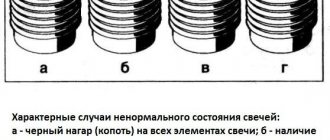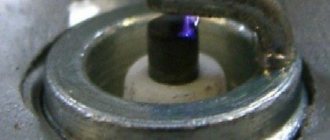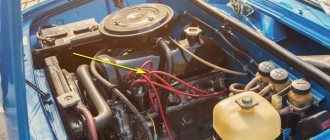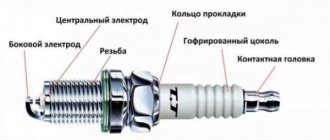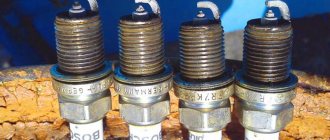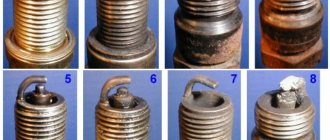Unlike diesel engines, the fuel mixture in the combustion chamber of a gasoline engine is ignited by an external source. This is a powerful electric discharge that jumps through the gap between the electrodes of the spark plugs. The latter are precisely designed to create a spark under conditions of high pressure and temperature characteristic of the gasoline combustion zone. The quality and rate of fuel combustion are influenced by many factors, including the distance between the spark electrodes.
When does spark plug gap need to be adjusted?
The gap on the spark plug is set at the manufacturing plant, and it should not worry the driver if the engine is running stable. But all cars can have problems in the combustion chamber, and many of them can be diagnosed by spark plug soot. Accordingly, in the event of certain malfunctions, the spark plug gap may change and will need to be set as recommended. Even with stable engine operation, the gap on low-quality spark plugs may change slightly, which is why it is not recommended to skimp on them. A slightly changed gap will affect fuel consumption, and the saying “the miser pays twice” will come into play.
Experienced car owners recommend checking the gap in the spark plugs and comparing it with the standards 2 times a year. This is due to the fact that every six months, caring drivers clean the spark plug from carbon deposits, and it is convenient to also adjust the gap during this procedure.
Design features and operating principle
Since the invention of the internal combustion engine, the principle of operation of the spark plug has not undergone major changes. Its main task is to convert electrical energy into a high-voltage arc, which ignites the fuel mixture in the combustion chamber.
- A ceramic insulator that ensures uninterrupted and stable spark formation.
- Metal housing for sealed installation in the engine.
- Electrodes for supplying and converting electric current into an arc (spark).
- The contact head, on many samples, has a thread for connection.
The most common, classic version of the candle has two electrodes, central and side. Current is supplied from the source through special high-voltage wires connected to the contact head to the spark plug, in the sequence established by the ignition system.
Gap between spark plugs - how does it affect engine performance?
The spark plug gap is usually understood as the distance between the upper and lower electrodes that create the spiral. On any model, the gap should be adjusted according to the manufacturer's recommendations, no more, no less. If the gap is different, the engine will operate intermittently, which can manifest itself in different ways: jerking, drop in speed, tripping.
If the distance is too small, there will inevitably be misfires in the ignition system, due to the fact that the spark created by the two electrodes is too small and is not always enough for the correct and timely ignition of the fuel. And if in an injection engine with small gaps the engine can operate properly and without interruptions for some time, then on carburetor engines problems will appear almost immediately after installing new spark plugs. In addition, the carburetor may simply flood, and this is fraught with more serious consequences.
Large gaps most often appear as a result of worn spark plugs or are a consequence of incorrectly selected models, for example, if you installed spark plugs that are recommended for one model on another.
Under the influence of high temperatures, the metal on them gradually burns out, the upper part stretches, the lower part sags, and soot forms, especially if low-quality fuel is used. Accordingly, the spark is stretched, which may not be enough for the normal functioning of the ignition system. Starting a car in winter with an increased gap on the spark plugs is almost impossible.
Therefore, experts recommend changing spark plugs at least every 20-25 thousand kilometers. If it is not possible to change them, then you need to at least clean them of the deposits that have formed, measure the distance between the electrodes and, if the design of the contacts allows, independently set this indicator to the recommended standard.
We recommend: Checking the car starter for operability
Interelectrode gap for different spark plugs
Cars that use gas as fuel involve a different method of fuel combustion. Thus, propane has a high octane number and high combustion temperatures. As a result, the use of spark plugs with the lowest heat value is required when refueling with 92-grade gasoline.
In a situation where the car is designed for 95 gasoline, then when installing gas equipment, you can use spark plugs with the recommended gap. Thus, it will not be possible to simply bend the side contact onto the spark plugs for a gas-powered unit.
Owners of foreign cars are often interested in the question: what gap between the spark plug and the “precious” electrode is considered normal? Spark plugs with a central contact made using iridium, platinum or silver are considered to be of higher quality. The contact gap in these parts is large. And the use of such “precious” metals affects the resistance of the material to high temperatures. This is based on the fact that the resulting spark charge is more stable and does not depend on the gap between the electrodes.
The reluctance to measure the spark plug gap is due to the slowdown in replacing old elements. But if you carry out this procedure in a store or directly at the car, you can avoid many problems during engine operation. After all, contacts can be damaged during transportation and loading, which in the future will affect the appearance of defects in the operation of the car.
The presence of interference when the fuel mixture ignites is often associated with improper operation of the spark plug, namely the inaccurate distance between the electrodes.
Signs of faulty spark plugs can be identified even by an inexperienced car enthusiast. An inexpensive part of the ignition system of a carburetor and injection internal combustion engine, it is indispensable for its stable operation. Their serviceability must be checked during scheduled maintenance, and replacement must be carried out in accordance with the regulations established by the manufacturer.
Gap between spark plug contacts on gas cars
When installing LPG, you must take into account: driving with spark plugs designed for gasoline will not work:
- ignition of the gas-air mixture occurs more slowly than the gasoline-air mixture, therefore, the spark for ignition must be more powerful;
- when the gas-air mixture ignites, the temperature is several times higher, so some elements of standard gasoline spark plugs may simply melt, the spark plug will begin to pierce, and a glow ignition effect will occur;
- The electrical resistance of the gas-air mixture is large; a voltage of 7 thousand V is required to break down the spark gap, that is, the load on the coil increases; if you do not install spark plugs designed for gas, you can break the coil.
Structurally, spark plugs for gas differ from spark plugs running on gasoline. They have a smaller spark gap to reduce the load on the coil, while their heat rating is higher, that is, they must be “cold”.
Reduced distance between electrodes
If this parameter is less than that recommended for this type of power unit, then the electric arc (spark) will be good, but short. In such a situation, most likely the short arc will not be enough to ignite the fuel-air mixture in the cylinder.
Since the mixture does not ignite, it means that it can flood the electrodes of the spark plug. The consequence of this will be that this cylinder is switched off from operation, that is, the engine will begin to “trouble.” If the gap is significantly smaller than recommended, the following can happen: when the internal combustion engine is running at high speeds, a powerful but short electric arc will not have time to open - there will be a continuous spark. The sad consequence of this may be a short circuit of the ignition coil.
What is the gap on spark plugs on gas?
Recently, the trend towards saving resources has been reflected in the automotive industry. Many car owners install modern gas equipment in their cars. However, not everyone knows that calibration is required for high-quality sparking.
After installing all the gas elements of the system, it is worth slightly raising the clearance on the spark plugs by one tenth of the rated gasoline value. Although the load on the built-in coil will slightly increase, the fuel gas mixture will ignite better, which will have a positive effect on the car’s power. Also, when choosing candles, it is important to give preference to products with a high heat rating so that the candles are “cold”.
The gap of an iridium spark plug has little effect on its performance. Contacts made of precious metals are more durable and produce a better spark. Additionally, the discharge bypasses the central contact along the diameter of the circle and ensures self-cleaning of this element.
The normal condition of the spark plugs is the key to the normal operation of the engine and its components. If you identify faulty spark plugs in a timely manner and replace them regularly, you will be able to avoid the vast majority of problems and protect yourself from burdensome and expensive engine repairs.
Heat number and “self-cleaning”
Temperature processes in the combustion chambers of different engine models have some differences. For optimal performance of spark plugs in each specific engine, they are certified according to the calorific value of combustion - heat number. For example, on a Ford Focus it is 7 and is written in the marking PFR7S8EG, after PFR, they belong to the “cold” class, used on engines with increased compression and compression ratio, for fuel with a high octane number.
Candles have a “self-cleaning” property, which provides for the combustion of the resulting soot particles at temperatures above 450 C degrees. This effect has a positive impact on the duration, quality of work and freedom from malfunctions. As a result of actions such as:
Prolonged operation of the engine at idle speed. Long-term movement without load at speeds not exceeding 2500 per minute. Frequent trips of less than 50 km in gentle mode.
Self-cleaning does not occur and the result is that a motor malfunction will not take long to occur. Fuel consumption will increase, power will decrease, failures and interruptions in engine operation will appear. Spark plugs do not like gentle operation and require periodic drive and loads.
Normal clearance size
The permissible limits of the interelectrode distance are from 0.6 to 1.2 mm. A more precise value is selected depending on the type of engine, power supply and ignition system:
- old-type carburetor engines with a low compression ratio and a mechanical spark generation system - 0.6–0.7 mm;
- the same engines equipped with non-contact electronic ignition – 0.8–0.9 mm;
- in turbocharged and naturally aspirated power units with fuel supplied by injection (injector), the gap on the spark plugs should be from 1 to 1.2 mm.
Advice. The best way to correctly determine the interelectrode clearance for a particular vehicle is to carefully study the operating instructions. In the vast majority of cases, this value is indicated among other setting parameters.
Since the owners of many vehicles equipped with gasoline engines switch to liquefied gas, the size of the spark plug gap requires adjustment. For high-quality combustion of a mixture of propane and air, it is recommended to increase the ignition intensity by increasing the clearance by 0.1 mm from the rated value. The load on the high-voltage coil will increase slightly, and the gas will burn better.
For example, the spark plug electrodes of a carburetor engine with electronic ignition must be bent to 0.9 mm, if the operating instructions indicate the figure 0.8. Do not listen to bad advice and do not make the gap too large, because automobile gas installations of all generations start on gasoline, and then automatically switch to supplying a propane-butane mixture from a cylinder. In addition, you will still have to use gasoline fuel to get to the gas station when the gas in the tank runs out.
We recommend: Removing scratches on a car body without painting
Setup recommendations
Checking and adjusting the gap on the spark plugs of the ignition system is carried out in the following situations:
- After repairing the engine, power supply and ignition systems, or before measuring compression in the cylinders. During operation, the spark plug electrodes gradually burn out and become thinner, causing the gap between them to increase.
- When replacing spark plugs with new ones. Often the manufacturer sets the gaps too small, which have to be increased to normal.
- When the engine became unstable. The first step is to unscrew the spark plugs, thoroughly clean the contacts, adjust the interelectrode distances and check their performance under pressure.
Cleaning the electrodes and pads from carbon deposits should always precede adjustment.
An important point to remember is that it is impossible to clearly set the gap on the spark plugs without a feeler gauge. Adjusting by eye will do as a temporary measure until you get to the garage with the tool.
- Remove the spark plugs from the engine cylinders and allow them to cool to room temperature. It is impossible to measure the size of the gaps “hot”.
- Clean the contacts with a wire brush and check the gap between the electrodes with a probe of the required thickness. The latter should fit tightly between the contacts, with little resistance.
- If the feeler gauge does not fit, increase the gap by bending the top electrode with a flat-head screwdriver. Too large a distance can be removed by gently tapping the contact.
It is easier to perform the operation on a cooled engine - you won’t have to burn your hands while unscrewing. For regular spark plugs, use a flat probe, and for products with 2-3-4 side electrodes, use a round tool. Install the spark plugs in the cylinders, start the engine and observe the idle speed. If the previously noticed vibration does not stop, the fault should be looked for elsewhere.
Owning a car means regularly replacing many parts. One of these parts are spark plugs, which are responsible for the timely ignition of the air-gasoline mixture. Their performance is assessed by analyzing the gap between the electrodes. It can vary depending on many factors. Therefore, if problems arise in the operation of the engine, the spark plugs are first checked. In this case, the gap between the electrodes is assessed. Then you can ask the question - what should be the gap on the spark plugs so that there are no problems in a running car.
The principle of operation of spark plugs in a gasoline engine
Spark plugs in any gasoline engine are an essential element that is responsible for contact with the fuel-air mixture, in other words, creating the necessary spark for the correct and uniform combustion of the fuel. The efficiency of their operation directly depends on their quality, the degree of wear, the gap between them, climatic conditions and fuel quality, as well as the performance of the car’s fuel pump.
As soon as fuel mixed with the required amount of air enters the engine cylinders, the piston begins to work, which builds up pressure. At the peak, upper point, the gasoline composition ignites, thanks to a timely spark created by the spark plug. The spark is created by a command from the control unit between the two electrodes of the spark plug and is a catalyst for combustion.
Thus, if the ignition system elements such as spark plugs are incorrectly or inadequately adjusted, the engine operates with low efficiency. Often there are shocks, a drop in speed when driving, and in the cold season, when the temperature drops noticeably below zero, the engine simply does not start. This can happen even when you install completely new spark plugs, and the reason is an incorrectly selected or set gap between them.
Why is it needed?
The gap between the electrodes of the spark plugs is necessary so that a spark can jump through it, which ignites the mixture in the cylinders. If the distance does not correspond to the norm, then instability of idle speed and even “triplication” of the unit occurs.
Such a “gift” can be received from the factory or by purchasing new candles from the seller. You can disassemble half the engine and not understand the reason. This is felt most strongly with a carburetor system. Let's start, as expected, with the principle of operation.
What are the acceptable standards?
The spark plug gap is usually called the size of the gap between the upper and lower electrodes. This parameter is determined by the make of the car and the technical characteristics of the engine. You can find the gap between the electrodes recommended by the car manufacturer in the vehicle’s operating instructions. In the absence of such documentation, it is possible to find the information of interest on the Internet.
What should be the gap between contacts? The vehicle’s ignition system affects the value of this parameter in the following way:
- the norm is considered to be a size of 0.5-0.6 mm in carburetor cars equipped with a distributor;
- a dimension of 0.7-0.8 mm is allowed in carburetor cars with electronic ignition;
- the distance within the normal range for injection machines is 1-1.3 mm.
The difference in recommended sizes is due to the electrical circuit and ignition system. Carburetor cars have the lowest voltage; for their normal operation, a weaker spark is needed, therefore, the gap is the smallest. For injection machines, the gap increases, since the voltage in the system is very high.
Let's consider two options for incorrect spark plug gap:
- very small;
- too big.
In the first case, due to insufficient distance between the electrodes, breakdowns will occur in the ignition system. The spark plug will be too small for normal ignition of the combustible mixture. In this case, the car will not gain momentum and will begin to twitch when driving. In the case of carburetor cars, it is possible to fill the spark plugs due to insufficient clearance, the engine will begin to stall.
A spark plug gap that is too small is considered to be within the range of 0.1-0.4 mm. Please note: there are engine modifications for which spark plugs with a very small gap between the electrodes are purposefully used - this allows the ignition system to be adapted to the increased power of the power unit. The principle is as follows: as power increases, the gap between the contacts decreases.
In the second option, a decrease in the spark passing between the contacts can be observed. It may not even be sufficient to ignite the fuel mixture. In this regard, breakdowns of the lower contact insulator are observed.
An increased spark plug gap occurs if the spark plugs are worn out: the material from which the contacts are made burns out with a large amount of mileage. At the same time, the lower electrode sags down, and the upper one loses its original rectangular shape; in cross-section it becomes like an oval.
We recommend: Advantages of ordering a car battery from a local company rather than from network companies
Please note: carbon deposits may form on the spark plugs, interfering with the passage of the spark. In this regard, as the mileage of the car increases, it is necessary to clean or replace the spark plugs. A gap between contacts of more than 1.3 mm is considered too large.
Increased distance between electrodes
The danger here lies in the possible breakdown of the spark plug insulator or even the ignition coil; the consequences of this are very unpleasant and costly. This occurs because current follows the path of least resistance.
Even if a breakdown does not occur, then, most likely, the increased gap will not provide the opportunity for the formation of a current arc, the so-called spark. The absence of a spark will lead to the fact that the working mixture in the cylinder will not ignite and, accordingly, this cylinder will not work. In such cases, they say that the engine is “troubling”, that is, 3 out of 4 cylinders are working. Also a sign of a larger gap than required is popping noises coming from the exhaust system.
An increase in the gap should not be attributed to any malfunction - this is a completely natural process that occurs over time, as the electrodes gradually burn out. Therefore, it is advisable to check the spark plugs during maintenance (after 10,000–15,000 km) and, if necessary, make adjustments, although the official dealer most likely will not “bother” with this topic and will simply offer a replacement.
The value of optimal clearances
Acceptable operating parameters at which the system remains fully operational are gaps in the range of 0.6–1.2 mm. Clear values are selected depending on the type of power plant, various power supply and ignition systems. You should focus on the following characteristics:
- old carburetor engines, which have motors with a low compression ratio and mechanical sparking functionality, will work optimally at 0.6–0.7 mm;
- similar power plants with modernized contactless ignition using electronics will be effective at 0.8–0.9 mm;
- for naturally aspirated engines reinforced with turbines and equipped with an injection type injection, it is preferable to provide a gap of 1–1.2 mm.
Pouring candles
How often do motorists come across the concept of “pouring candles”. Moreover, they can either become oily or filled with fuel. We'll talk about this later.
Fills with fuel
To check the spark plugs you will need to remove them and visually inspect them. Plus check the condition of other elements that are directly involved in starting the engine. Namely:
The spark plugs may become flooded, splashed with oil, and the spark may disappear due to contamination, oiling, and carbon deposits.
Why are the candles filled with gasoline?
- This usually happens in the cold season, when the compression in the engine is weak;
- There is a lot of oxygen in the air, so more fuel is used for combustion;
- The injectors begin to supply fuel;
- If the battery is poorly charged, the starter stops turning properly, the wires do not supply the required charge to the electrodes;
- All this leads to the fact that a large amount of fuel comes from the injectors, which the candles simply do not have time to burn. As a result, they are flooded.
Fills with oil
There are also cases when the culprit in the failure of the spark plugs is the oil that splashes them. To make sure of this, check the condition of the spark plug wells and oil scraper rings.
A small amount of oil can seep through these rings, so when you start the engine it immediately burns out and there is no trace left of it. But if the rings are worn out, it is better to replace them.
Please note that the spark plugs may also be filled with oil due to wear on the cylinder liners and valve seals. Do not confuse traces of oil with carbon deposits formed during the combustion of gasoline.
Engine diagnostics based on carbon deposits on insulators
Take this opportunity to look at the spark plug insulators; their appearance can tell you a lot; you just need to understand what it says. After all, this element of the ignition system works in the combustion chamber of the cylinder and all the processes taking place there are reflected in its condition and appearance. It would not be an exaggeration to say that it is also a diagnostic probe built into the heart of the engine.
- The spark plug insulators are in good working order and the engine is running should be light brown in color and should not have soot deposits or burnt oil. If the spark plug insulator and the central electrode are covered with a velvety black coating, then this indicates either a malfunction in the ignition system or incorrect adjustment of the system preparing the fuel-air mixture, and if the engine is fuel-injected, then one of the sensors of this system may fail.
- The color of the insulator from light gray to white without carbon deposits indicates an excessively lean mixture.
- The brick-red color of the insulator indicates deposits of tetraethyl lead on it and that this spark plug, without cleaning, will soon experience an electrical breakdown of the insulator and failure.
- Traces of oil on the spark plug, as you might guess, indicate increased oil consumption. To determine its cause, observe the exhaust immediately after starting the engine. If there is a blue cloud of smoke with the smell of burnt oil, this indicates that while the car was parked, oil has accumulated in the combustion chambers through the valve seals. So it's time to change the caps. If the smoke is all blue from starting the engine and beyond, then the reason for oil consumption is most likely wear on the piston rings.
- A thick, white, loose coating on the spark plug appears when antifreeze enters the combustion chamber; this happens when the gasket between the cylinder head and the cylinder block is defective or due to thermal deformation of the cylinder head. When an engine operates with such a malfunction, bubbles of exhaust gases are observed in the expansion tank, passing into the cooling system through the same defect. The exhaust from such a malfunction partly consists of coolant vapors.
How to measure the gap between electrodes
The gap between the electrodes changes during operation, since the spark plug is constantly exposed to electrical voltage and high pressure. It is recommended to check the distance between the electrodes every 15 thousand km. (or 30 thousand km for multi-electrode devices) and correct it.
To measure, you will need a special tool - a probe. Three types of tools are used:
- Coin-shaped - along the edge of the “coin” there is a thickening rim, which is the meter. Insert the rim between the electrodes and turn the “coin” so that the rim stands between them. Then look at the designation that is printed on the disk. It indicates the width of the rim at a specific point. The disadvantages of such a probe are that it can become worn down and can accidentally increase the gap between the contacts.
- The coin-wire device is also a round tool, but the gap is measured by inserting wires attached to the body between the electrodes. They have a fixed thickness, so it is not possible to accurately determine the distance.
- Flat probe - the tool is a set of probes that differ in thickness. It looks like a Swiss Army knife. To make a measurement, select a probe of the required thickness (several probes can be used). There are tools of a combined type with wires, that is, combining this and the previous options.
To measure the gap, the spark plugs are removed from the engine. To do this, you will need a 16 or 21 head. First, disconnect the armor wires, and then unscrew the spark plugs. The removed devices are cleaned to remove carbon deposits and obtain a reliable measurement result.
Important! A large amount of carbon deposits indicates that the spark plugs will soon need to be replaced. If the carbon deposits are not completely cleared, then putting them back is not recommended.
You can use a small piece of clean cloth for cleaning. If you cannot remove the deposits with a cloth, you should apply medical alcohol to the surfaces of the electrodes.
After cleaning, measure the gap with a tool by placing the probe between the electrodes. Select a probe that corresponds in thickness to the value that needs to be set. If the probe does not fit between the contact surfaces, then the gap needs to be increased. If the probe fits freely between the electrodes, you need to bend the contacts in the direction of decreasing the distance. The probe should fit tightly between the contacts.
Advice on choosing candles and how to spot a fake
Long gone are the days when the question “Which spark plugs to buy?” was not needed, because only domestic ones were on sale and only of the same model as those on the car. Nowadays, store shelves are littered with a huge selection of candles from almost all foreign manufacturers. This naturally gave impetus to scammers to counterfeit them, the price does not correspond to the quality, so pay attention to the following:
- To avoid getting caught by a fake, pay attention first to the packaging - the quality of printing from branded manufacturers is excellent, but on a fake, the contours of the drawings may not match
- If there is no packaging at all, then further inspection makes no sense; branded candles are not produced without packaging
- Then we inspect the spark plugs themselves
- Their central electrode must have a clear cylindrical shape, and the surface of the electrode must be completely smooth
- When defects are visible on the electrode or the electrode itself is installed crookedly, you know that this is a 100% fake.
- In a fake spark plug, the side electrode is often welded crookedly and has oblique edges. The threads of branded spark plugs are made by knurling, so they are absolutely smooth
- The fake has small chips because it is made by cutting
- The sealing ring of a branded spark plug cannot be removed
- On a fake candle, this ring is either unscrewed along the thread or simply removed
- The insulator of the branded candle is shiny and absolutely smooth
- In fakes, longitudinal seams are often noticeable due to inaccurately joined molds
- In addition, the inscription on the insulator of a branded candle is always clear, even and neat
- And the last sign - real branded candles cannot be cheap
- Let the low price alert you
Now that we have dealt with the candles, watch the video as well.
Source


